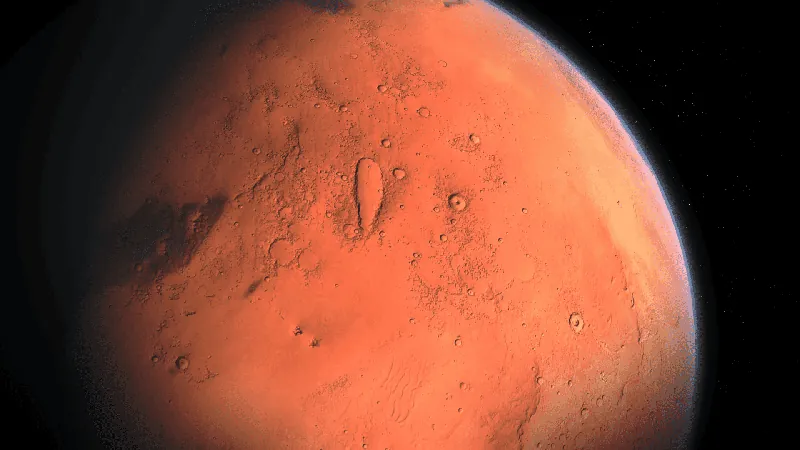
Could Mars' Earthquake Chemistry Spark Life Beneath Its Surface?
2025-07-31
Author: Li
Unveiling Mars' Hidden Potential for Life
Mars, the enigmatic Red Planet, might just be a hotbed of microbial activity lurking beneath its dusty exterior. Recent research from Chinese scientists published in *Science Advances* presents groundbreaking findings: seismic activity on Mars could facilitate chemical reactions that generate life-sustaining ingredients deep within the planet's crust.
The Chemistry of Quakes: A Recipe for Life
In a fascinating twist of fate, when quartz-rich rocks on Mars crack and encounter water, they kickstart a series of reactions yielding hydrogen gas and oxidants. On Earth, these elements form a trifecta vital for microbes that thrive in subterranean environments far from sunlight. If similar processes occur on Mars, our neighboring planet’s frequent quakes and ancient watery past might conceal countless life-sustaining niches.
From Earth to Mars: A Comparative Analysis
The concept is simple yet profound: rocks under immense stress break apart and unleash their reactive surfaces. When they interact with water, hydrogen and oxidants rapidly surface. The laboratory simulations tested two types of faults, with one type (breaking first and then meeting water) producing a sharper chemical seal, trapping hydrogen gas while supplying dissolved oxidants—a chemical feast that Earth microbes feast upon.
Staggering Numbers: The Hydrogen Reservoir
To put this in perspective, shallow earthquakes on Earth produce roughly 110 million moles of hydrogen annually—enough to fill about 1,000 Olympic-sized swimming pools! In local terms, this translates to an astonishing 33 moles of hydrogen per square meter of fresh fault wall each year. That’s more than enough to sustain active microbial communities underground.
Mars: A Stage Set for Life?
Mars is teeming with conditions that favor this kind of chemistry. Earlier observations revealed over 15,000 kilometers of ancient riverbeds in the Noachis Terra highlands, where long-lost rivers once flowed, allowing water to seep into cracks and pores—much like the simulated reactions in the lab.
Oxidants: Mars' Chemical Allies
Moreover, Mars comes equipped with its own oxidants. NASA's Phoenix Lander discovered perchlorate salts in Martian polar soils—moisture-attracting compounds that can form salty brines. Even small traces of hydrogen peroxide detected in the planet’s thin atmosphere could play a role underground, serving as a vital partner in the chemical dance with hydrogen.
Marsquakes: Nature’s Chemical Factory
From 2018 to 2022, NASA's InSight Lander monitored over 1,300 marsquakes, some stemming from deep tectonic shifts. Each quake that expands cracks or shatters grains likely ignited the same rapid chemical reactions observed in the lab, releasing precious hydrogen and oxidants into remaining groundwater pockets.
Lessons from Earth: A Microbial Blueprint
Comparative studies on Earth, such as those at Kidd Creek mine in Canada, showcase how trapped water in rocks provides a nurturing environment for microbial life, even in total darkness. This isn't definitive proof that Mars operated under similar conditions, but it certainly lays down a logical pathway for possibilities.
Insights for Future Mars Missions
This research offers a roadmap for upcoming Mars missions. Scientists should explore ancient fault zones, sample minerals within fractures, and look for a combination of clues—hydrogen, traces of peroxide or oxygen, methane, and transformed iron. Although no single clue will definitively indicate life, collectively they could illuminate where resilient microbes might have found respite in the unforgiving Martian landscape.

 Brasil (PT)
Brasil (PT)
 Canada (EN)
Canada (EN)
 Chile (ES)
Chile (ES)
 Česko (CS)
Česko (CS)
 대한민국 (KO)
대한민국 (KO)
 España (ES)
España (ES)
 France (FR)
France (FR)
 Hong Kong (EN)
Hong Kong (EN)
 Italia (IT)
Italia (IT)
 日本 (JA)
日本 (JA)
 Magyarország (HU)
Magyarország (HU)
 Norge (NO)
Norge (NO)
 Polska (PL)
Polska (PL)
 Schweiz (DE)
Schweiz (DE)
 Singapore (EN)
Singapore (EN)
 Sverige (SV)
Sverige (SV)
 Suomi (FI)
Suomi (FI)
 Türkiye (TR)
Türkiye (TR)
 الإمارات العربية المتحدة (AR)
الإمارات العربية المتحدة (AR)